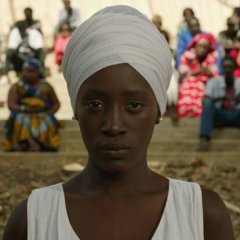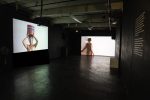Vox Populi; We’re working on it, Andrew Suggs, ed. (Vox Populi Gallery, Philadelphia)
ISBN 978-0-615-31338-2
The art scene in Philadelphia is marked by an expanding community of artists, artists’ collectives and artist-run organizations, galleries, publications and events. Word gets out, but proper documentation is important for an accurate picture and for the future. In a publication recording its 21-year history, Vox Populi Gallery has provided a record of its own history as well as that of the other artists’ organizations established in Philadelphia since the founding of Painted Bride in 1969.
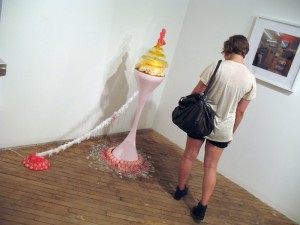
Vox Populi; We’re working on it is fully-illustrated in color, with two pages devoted to each of the current members, double-page spreads of exhibitions of Vox alumni and others in curated and juried selections, a review of video lounge presentations and a variety of historical photographs. Andrew Suggs, Vox director, has done an enormous job in gathering a wealth of information, essays, and illustrations from a large number of contributors.
Amy Adams (former Vox director) has written a very clear history of the organization which makes an excellent case study in artist-run organizations. She describes Vox’s growing pains and successes as members adjusted to a changing mission (moving from open membership to peer-review), financial needs, group decision-making, urban gentrification, incorporation and changes in the art world in Philadelphia and beyond.
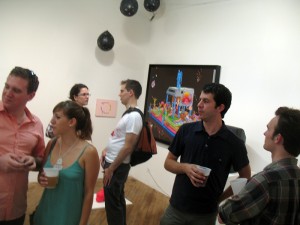
Art historian and critic, Paul Galvez, discusses a history of 20th century artists’ collectives, from OBMOKhU in the early Soviet Union to Warhol’s Factory with its model of art as business. He also discusses Philadelphia’s self image and its uneasy relationship with New York and New York publications of record, with their national audience (hence the real concern with what is written in the New York Times, despite the stature of the stringer who likely wrote any particular article).
An essay by Richard Torchia, artist and gallery director, covers a history of artist-run spaces in Philadelphia followed by a time-line with a paragraph-long description of each organization, extant and defunct. Torchia includes a series of serious and provocative questions including Do artist-run spaces, by definition, need to be non-profit?, Given the pre-condition that selling art is not a viable goal in a city without a sufficient collecting population, what are the criteria for measuring success in a community with so few platforms for criticism and discourse? and Are we approaching a point at which there are more individuals on stage than in the audience? Torchia’s contribution is generous to his readers and to anyone who wants to catch up on an otherwise unavailable history of the past 50 years of grass-roots art activities in Philadelphia.
By choosing to present its own history as thoroughly embedded in a longer and broader story, Vox Populi represents the artist-run organization at its best: inclusive, community-oriented, mentoring the next generation and a crucial resource for the larger community that wants to follow the area’s art from its points of origin. Thanks to all involved!
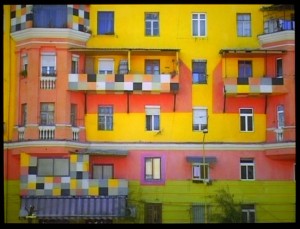
Communities of Sense; Rethinking Aesthetics and Politics, Beth Hinderlitter et al, eds. (Durham and London: Duke University Press, 2009). ISBN 978-0822345138
This volume of a dozen essays and one interview grew out of a conference of the same name held in 2003 at Columbia University. It takes up the ideas of political philosopher Jacques Rancière as a means of theorizing the relationship between aesthetics and politics in the global world. For those writing about art who have followed a largely-Francophone sequence of theorists (Althusser, Foucault, Derrida, Lacan, Barthes, Kristeva, Baudrillard, Irigaray, Bourriaud…), Rancière appears to be the current favorite.
Several contributors, including Rancière himself, discuss the relationship of aesthetics and politics from the Enlightenment to the present. Rancière suggests that art offers a space for disagreement and the expression of minority opinion within a non-hierarchical and collectivist politics. Alexander Potts, whose writing has a clarity that is exceptional in this compilation, looks at the Romantic artists’ rejection of the reigning aesthetic as a background for recent anti-aesthetic impulses. He uses the work of Hegel to examine Delacroix and Turner’s rejection of the totalizing aesthetics of Classicism; Potts uses specific works as examples of paintings that are de-centered, violate unity of time, depend upon the accompaniment of texts and involve ironic humor.
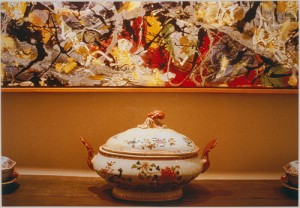
A number of contributions look at specific examples of art as political dissent on the one hand, and artists as participants in community-formation directed at social change on the other. T. J. Demos writes about Dada events as political antagonism via transgressive acts which inherently re-configure the relationship between art and politics. Toni Ross attempts to understand the aspect of Louise Lawler’s photographs that exceeds their function as institutional critique. Carlos Basualdo and Reinaldo Laddaga examine Marjetica Potrc’s work with a community group in an outlying area of Caracas as an example of an artist’s involvement in what they term an experimental community; her participation addressed problems in the world at large and at the same time generated work that circulates within the traditional spaces of the art world.
These essays will be useful for readers who want to follow current theoretical approaches to art, but I must admit to a fair degree of skepticism about the whole project. The authors are largely senior faculty at universities, surely as hierarchical as any current institutions; they write about a politics of the left, which is inherently populist and anti-hierarchical, in a dense and exclusionary language. I am also prejudiced in being an adjunct faculty member, the proletariat of higher education; yet I don’t see such senior faculty at the barricades on behalf of just compensation or communally-shared resources and decision-making within higher education, a sphere where they enjoy real power.





